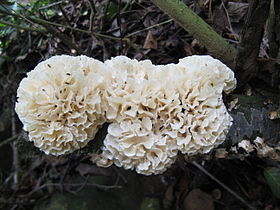Irpicaceae
| Irpicaceae | |
|---|---|

| |
| Irpex lacteus | |
| Scientific classification | |
| Kingdom: | Fungi
|
| Division: | |
| Class: | |
| Order: | |
| Family: | Irpicaceae Spirin & Zmitr. (2003)
|
| Type genus | |
| Irpex Fr. (1825)
| |
The Irpicaceae are a family of mostly polypores and crust fungi in the order Polyporales.
Taxonomy[]
The family was circumscribed in 2003 by mycologists Viacheslav Spirin and Ivan Zmitrovich. The type genus is Irpex.[1] Later multi-gene phylogenetic analyses of the Polyporales supported the use of this family. In these analyses, Irpicaceae is a sister taxon to the Meruliaceae; these two families, as well as the Phanerochaetaceae, form the phlebioid clade.[2][3]
Description[]
Irpicaceae has both polypore and crust fungi. They have a monomitic hyphal system, containing only generative hyphae that do not have clamp connections. Their spores are thin-walled, smooth, and translucent. Cystidia are often absent from the hymenium. More rarely, some species are dimitic and/or with cystidia and/or clamp-connections present; for example, Emmia and Irpex have cystidia, and there are clamp connections in Gloeoporus. Irpicaceae fungi produce a white-rot, except for one brown-rot genus (Leptoporus).[3]
Genera[]
- Byssomerulius Parmasto (1967)[4] – 9 species
- Ceriporia Donk (1933)[5] – 57 species
- Efibula Sheng H.Wu (1990)[6] – 16 species
- Zmitr., Spirin & Malysheva (2006)
- Ryvarden (1973) – 3 species
- Gloeoporus Mont. (1842) – 32 species
- Hydnopolyporus D.A.Reid (1962)[7] – 2 species
- Leptoporus Quél. (1886) – 12 species
- Meruliopsis Bondartsev (1959) – 2 species
- Trametopsis Tomšovský (2008)[8] – 3 species
According to Justo and colleagues, several genera from various other Polyporales families contain species that should be in the Irpicaceae, and will need to be reclassified. These include: Candelabrochaete ( and ), Ceraceomyces (, , and ), Ceriporia (), Ceriporiopsis ( and ), Hapalopilus (), Phanerochaete (P. allantospora, , , , , , and ), and Phlebia (, , and .[3]
|
References[]
- ^ Spirin, W.A. (2003). "Antrodiella romellii (Irpicaceae, Basidiomycetes) in Russia". Mycena. 3: 47–52.
- ^ Miettinen, Otto; Spirin, Viacheslav; Vlasák, Josef; Rivoire, Bernard; Stenroos, Spoili; Hibbett, David S. (2016). "Polypores and genus concepts in Phanerochaetaceae (Polyporales, Basidiomycota)". MycoKeys. 17: 1–46. doi:10.3897/mycokeys.17.10153.

- ^ a b c Justo, Alfredo; Miettinen, Otto; Floudas, Dimitrios; Ortiz-Santana, Beatriz; Sjökvist, Elisabet; Lindner, Daniel; Nakasone, Karen; Niemelä, Tuomo; Larsson, Karl-Henrik; Ryvarden, Leif; Hibbett, David S. (2017). "A revised family-level classification of the Polyporales (Basidiomycota)". Fungal Biology. 121 (9): 798–824. doi:10.1016/j.funbio.2017.05.010. PMID 28800851.
- ^ Parmasto, E. (1967). "Corticiaceae URSS IV. Descriptiones taxorum novorum. Combinationes novae". Eesti NSV Teaduste Akadeemia Toimetised, Biologica (in Latin). 16: 383.
- ^ Donk, M.A. (1933). "Revisie van de Nederlandse Heterobasidiomyceteae (uitgez. Uredinales en Ustilaginales) en Homobasidiomyceteae-Aphyllophraceae: II. Mededelingen van het botanisch Museum en Herbarium van de Rijksuniversiteit Utrecht" (in Dutch). 9: 170. Cite journal requires
|journal=(help) - ^ Wu, S.H. (1990). The Corticiaceae (Basidiomycetes) subfamilies Phlebioideae, Phanerochaetoideae and Hyphodermoideae in Taiwan. Acta Botanica Fennica. 142. Helsinki: Finnish Botanical Publishing Board. p. 21. ISBN 9789519469362.
- ^ Reid, D.A. (1962). "Notes on fungi which have been referred to the Thelephoraceae senso lato". Persoonia. 2 (2): 109–170 (see p. 151).
- ^ Tomsovsky, M. (2008). "Molecular phylogeny and taxonomic position of Trametes cervina and description of the new genus Trametopsis". Czech Mycology. 60 (1): 1–11. doi:10.33585/cmy.60101.
- Irpicaceae
- Polyporales families
- Taxa described in 2003


